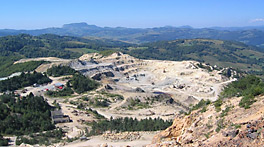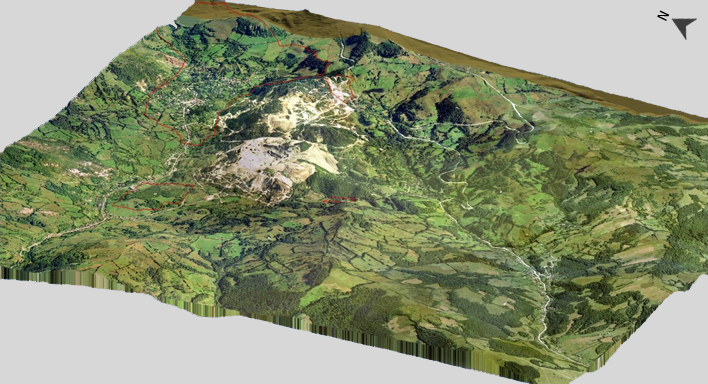Underground operations at Rosia Montana ceased in 1985, but state operated open pit mining continued until 2006, leaving an obvious effect on the mountain landscape.
The Project could generate over $500 million in revenues per year, sustaining hundreds of direct jobs and thousands of indirect jobs and reinvigorating the regional economy.
The proposed mine and mill site are located within steep hilly/mountainous terrain at an elevation of approximately 850 metres above sea level. The proposed tailings management area is located in the immediately adjacent valley to the mine/mill complex at approximately 600 metres above sea level.

Above: the legacy of open pit mining at Rosia Montana.

Above: An illustrative diagram of the current landscape
Mining Process
Gabriel planned to use conventional processes and Best Available Techniques to extract the gold and silver from the ore in the four proposed pits at Rosia Montana.
Backgound to Proposed Operations
Since the issuance of the Exploitation License, Gabriel and RMGC focused substantially all management and financial resources on the exploration, feasibility and subsequent development of the Project. Consistent with objective of creating a high-quality, sustainable and environmentally-responsible mining project, Gabriel and RMGC engaged leading global mining, engineering, and environmental consultants and experts to assist in the development of all major aspects of the Project. Working with these consultants and experts, Gabriel implemented the following steps, among others, to develop the Project:
- undertaking extensive exploration activities within the Project area, including an extensive drilling and assaying program, which confirmed the existence of significant mineral deposits within the Project area;
- undertaking extensive and updated feasibility studies and development plans for extraction of gold and silver from the Project (including basic engineering and the initial aspects of the detailed engineering phases of development for the Project);
- developing the technical design of the Project;
- purchasing and storing mining and other equipment necessary to implement the Project, such as large-scale equipment for the processing plant;
- undertaking wide-ranging and comprehensive environmental impact assessments;
- undertaking and financing extensive corporate social responsibility programs in the Project area, including education and training programs, improvements to infrastructure, renovation of historical buildings and monuments, and other projects enhancing sustainability and social progress;
- acquiring surface rights to land within the Project’s footprint and, following public consultations and in accordance with World Bank principles, relocating and resettling members of the local community affected by the Project;
- undertaking and financing extensive programs of exploratory and preventive archaeology to identify and preserve sites and artefacts of historical importance in the Project and surrounding area; and
- pursuing applications for and acquiring permits and authorizations required to implement the Project and defending the same against a multitude of legal challenges by, amongst others, anti-mining NGOs.


